A journey along Japan’s oldest pilgrimage route
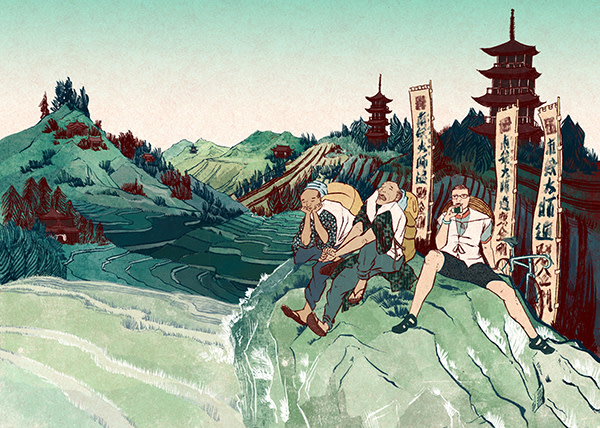
Simply sign up to the Life & Arts myFT Digest -- delivered directly to your inbox.
Sayuru Kunihashi had paid the bill for a night on a tatami straw mat, eaten a breakfast of fish and rice and absorbed the directions for the day ahead. Her watch said 7.20am and she was dressed to depart. A sedge hat for the strong sun, a wooden staff for the rough terrain and a white funeral robe. The latter was an emblem of her journey — a trek into the realm of death. She had already walked 584 miles along Japan’s oldest pilgrimage route, the Shikoku henro, and that day she would make the treacherous ascent of Mount Unpenji, a peak named after the place at its summit, the Temple in the Clouds. It is the highest point on the pilgrim trail, the 66th stop on a circuit of 88 Buddhist temples. The route circles Shikoku, a rugged island in south-west Japan that is synonymous with exile in national folklore, a remote and frightening place of dark forests and stormy seas. For hundreds of years, pilgrims who wore the funeral robe were ready to be struck down by illness or accident. The path is still dotted with the gravestones of those who never made it back.
Today, the pilgrimage’s 850 miles no longer threaten walkers’ lives, though some trucks do as they thunder past the ramen-thin sidewalks. Yet the journey is still an act of rupture, a voyage into an “other” world. The symbolism of death remains potent. Those who embark on the journey are severing ties — at least temporarily — with their homes and everyday lives. “To die is to lose everything,” one temple priest told me. “The pilgrimage is like virtually dying. You lose everything you have. It’s a form of ascetic training. You leave all your physical and mental baggage behind.”
Kunihashi, then 47, had left most of hers in Tokyo, where she taught cooking. Her accessories honoured the pilgrimage’s spiritual founder, Kobo Daishi, a wandering holy man who helped to establish Buddhism in Japan. His name was celebrated in a mantra written in thick brushstrokes on her robe; his form was said to be embodied in the wooden staff she carried. Born in 774AD, he travelled to China to study as a young man and returned home two years later to found the Shingon sect of Buddhism. According to legend, the pilgrimage passes the places where he worshipped. In truth, its precise origins are unclear. It is doubtful the Daishi established the route himself. More likely is that his disciples created it after his death.
There are no definitive counts but each year between 80,000 and 140,000 pilgrims — known as o-henro — are estimated to travel at least part of the route. According to one survey, around 60 per cent of them are over the age of 60. The vast majority speed around on air-conditioned bus tours but a hardy band of 2,000-5,000 are estimated to do it on foot, usually completing the circuit in 40-50 days.
Kunihashi let me join her on the mulchy trek up through the cedar trees of Mount Unpenji. It took us three hours to emerge from the green gloom on to a stone courtyard hemmed by spotless temple buildings. There, Kunihashi began a series of rituals that culminated in a chant of the Heart Sutra, a Buddhist prayer that she had memorised. “People who do it without reading anything look cool, don’t you think?” she said. That’s why she had decided to learn it from YouTube. She pulled out her iPhone to show me a musical version of the sutra sung by Hatsune Miku, a wildly successful Japanese pop star who happens to be a cartoon character.
On the way up the mountain, Kunihashi had stopped to bow in front of a glass cabinet that contained a few small Buddhist statues. I asked her what they represented. She said: “I have no idea.” We talked about religion. She told me that like many Japanese people she had married in a Christian ceremony, and that on New Year’s eve she prayed for good luck in the year ahead at a Shinto shrine, the worship place of an indigenous faith that predates Buddhism. She said Japanese people believed in gods of trees and mountains, too. “There’s even a toilet god,” she added. “She’s supposed to be very beautiful.”
So was religion what brought her to the pilgrimage? No, she said. She was not religious “in the western sense”. She was doing it because she had won an iPad in a competition by saying she would use it to document the henro: “If there’s something you have to do, life has a way of pushing you into doing it.”
Japan special
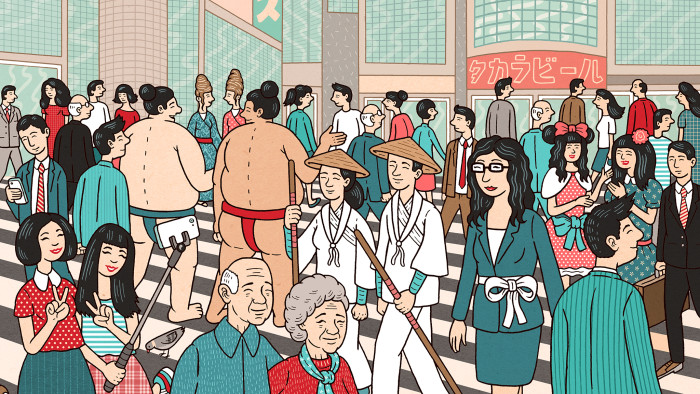
The art of growing old
Ageing gracefully in Misaki
On the march to power
Outspoken nationalist Tomomi Inada
Treasures of the Tang trail
Nara and Kyoto’s Chinese visitors
In the sumo ring
How sumo wrestlers train — and eat
Cornucopia utopia
Japan’s 24-hour convenience store
Tea, trains and Bowie
Must-do dates for the diary
Q&A: Quintessentially Japanese
What frequent visitors like most about Japan
Japan is dotted with temples and shrines but religion’s imprint on the country’s mental landscape is often barely perceptible. Like Kunihashi, three quarters of Japanese people say religion is not an important part of their daily lives, according to a Gallup survey. At the start of the new millennium, I studied the Japanese language and reported on the country for nearly four years from Tokyo. In all that time, religion never really came up. That was why I was intrigued when I heard about the Shikoku henro. Its popularity seemed paradoxical. My chance to take the journey came three years ago, a year before the pilgrimage’s official 1,200th anniversary in 2014. In the time since, as I’ve lived in New York and Washington DC, the journey has never been far from my mind. When the rat race is getting to me, it is soothing to remember that there is always someone out there in a white robe, trekking to the next temple, whatever their motive.
. . .
In 1927, a bespectacled German teacher called Alfred Bohner embarked on the henro. He went on to write a book about it called Two on a Pilgrimage and rebuked those non-pilgrims who imagined the journey to be a form of recreation. The labour and humiliations of the trip, he explained, quickly weeded out the halfhearted. The pain of battered feet was compounded by having to stay in “miserable lodgings with a wretched bed and slender fare”. Bohner was particularly troubled by vermin, and reported one morning discovering a “well-nourished body louse” on his small Japanese towel.
Pilgrims today move between city pavements, paddy fields, ocean highways and woodland trails. I travelled the route by bicycle, spending three weeks in the saddle from 8am to 6pm every day and getting a leg-sapping lesson in how a mountainous country really feels. Accommodation, however, has improved since Bohner’s time. I stayed in neat hotels and inns that were blushingly cushy compared with the park benches and bus stations where the noblest walking pilgrims still sleep.
The motivations of my fellow travellers, however, were not radically different from those Bohner encountered. Some pilgrims had set out to reckon with anguish, misfortune or personal failure. Others were seeking to heal illnesses. Many travel to memorialise relatives who have passed away. The spirits of the recently deceased are said to be unstable in Japan, even dangerous, and the pilgrimage can help to calm them. A young woman I met called Junko Kosaka carried a stamp album, one of the pilgrimage’s iconic mementos, which was marked at each temple with red seals and an inscription of the institution’s name and principal deity. Once the album is completed, it is said to take on sacred powers. Kosaka said she would place it in the coffin of one of her parents when they died, to put them on the fast track to heaven.
One night, Toyokazu Akita, the owner of an inn where I stayed, told me that after he and his wife lost a son 30 years ago, they did the pilgrimage to mollify his spirit, but that the temples had calmed their own emotions too. “We met a lot of other people going through troubles of their own,” he said. “Sharing things with them made us feel better.”
Certain temples specialise in blessings for getting pregnant, passing an exam or resolving eye problems. Some offer protection for people at unlucky ages: 42 for men and 33 for women. “If you’ve got 100 people, you’ll find 100 reasons for doing the pilgrimage,” a temple priest told me.
The temple rituals are a kaleidoscope of their own. Pilgrims can wash their hands in holy water. They can ring a giant bell. They can throw coins into a tray. They can burn a stick of incense. They can read the Heart Sutra and at least six other prayers. But pilgrims do as much or as little as they like. There is no correct way to perform the henro. I wanted to find out what underlying beliefs might tie it all together.
On my first day I had been warned that this would not be easy. As I visited a string of temples along the Yoshino river, I stopped to talk to a junior priest called Naoki Maeda at temple 2. He told me to remember one thing: Japanese people are not great talkers. “Speech is the silver medal. You get the gold medal for not speaking.”
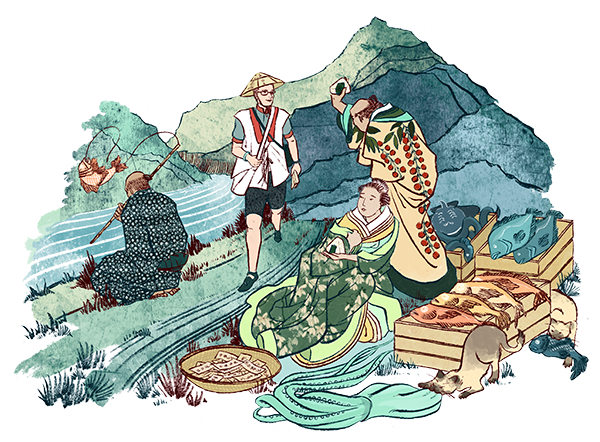
The spiritual implications of this had been understood by Lafcadio Hearn, an Irish-Greek who came to Japan in 1890 and became a naturalised Japanese citizen, the priest said. Hearn’s point about Japanese people, as Maeda saw it, was that “their lifestyle, their way of thinking, is religious, but if you put it into words, they dispute that”. He told me to read some of Hearn’s writing and I found a passage in which Hearn said that religion “as mere doctrine” would ultimately fade away but that “religion as feeling” could never die.
In the days that followed, this began to make sense. When pilgrims told me they were not religious, I asked them where, or to what, they were directing their wishes, prayers and offerings. If they had any answers at all they were ambiguous. That partly reflected the blurred boundaries between faith and tradition in Japan. One pilgrim, a former Toyota factory worker called Kenzo Oshima, told me he was “absolutely not” religious and was walking the route to fortify his health. Yet at each temple he dutifully read the Heart Sutra because “it’s a matter of good manners”.
There is also a fuzzy line in Japan between the spiritual and the day-to-day. Rather than existing in some alternate realm, the spirit world envelops everyday experience like the weather. “These are not things that Japanese people think about with great precision,” said Shinichi Takiguchi, who publishes a monthly henro newsletter. “People approach spirituality in a kind of foggy way. It’s a bit like they’re daydreaming.”
Some pilgrims pick a spiritual figure as a lodestone for their journey, be it a deceased grandparent, Kobo Daishi, a mountain god, Buddha or something else. But there was no conflict between the spirits, said Kunihashi, the woman I followed up the mountain. Instead, the spirits complemented each other. “I don’t say ‘My god is right and yours is wrong’,” she said.
Some pilgrims, however, were deeply suspicious of institutional religion. Two priests I spoke to linked this to the scars of the second world war and the emperor worship on which wartime indoctrination depended. A professor cited the 1995 gas attack in which members of the Aum Shinrikyo cult released sarin on the Tokyo subway, killing 13 people and stirring fears of new dangers in organised faith.
. . .
Behind the temples’ grandiose façades, priests occupy a sedate tatami world of slippers and green tea. I wanted to know what they made of the pilgrims’ spirituality. What they revealed was considerable ambivalence. When I asked about the chattering henro on bus tours, most priests decided that the dignified thing to do was to say little. They were more respectful of walking pilgrims. But several said they wanted the footsore travellers to appreciate that the journey depended on more than their own stamina. One of them was Hakushou Kubo, the deputy chief at temple 37. “You can’t do the henro alone,” he said. “You need the weather to be on your side. You need the help of nature.” Three days earlier a typhoon had swept across Shikoku, drenching me, so I was inclined to agree.
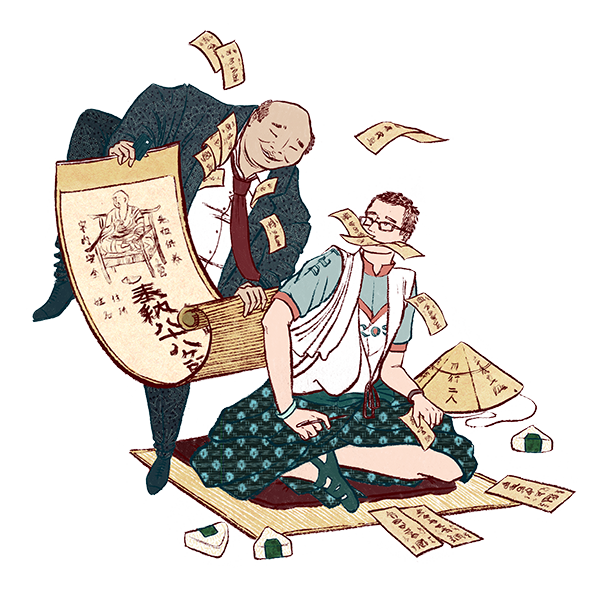
Other priests were eager to emphasise the importance of Kobo Daishi. But Shunshou Manabe, the chief at temple 4, said that pilgrims’ awareness of him had become diluted in recent years. “If you put it in terms of sake, it’s as if the people who like pungent sake are falling in number. And the people who like sweet sake — the easy-to-drink ones — are increasing,” he said. I asked if that saddened him. “No, it’s not sad at all. Kobo Daishi’s teachings lead to that kind of approach. To be captured by something is to become a slave to it. That is what you must avoid.” The Daishi’s lesson was to not get hung up on the Daishi.
. . .
I was locking my bike to a railing in the car park of a noodle restaurant seven days into my journey when I heard a cooing voice behind me: “O-henro-san, o-henro-san.” I turned around to see an old lady with grey pigtails, who had spotted my white funeral vest. “You don’t meet a pilgrim every day,” she said excitedly. Her enthusiasm threw me — as did her enquiry into whether I had any “name slips”. These pieces of paper, sold in packs of 200 in temple shops, come printed with a dedication to Kobo Daishi and space for your name, address and the date; it is tradition to leave one in a box at each temple’s main building. I knew pilgrims sometimes gave them to people they met, but I didn’t expect to be asked for one outright. I handed over a slip and the old lady asked me to add my age and birthday. In return, she dug into her handbag and gave me two boiled sweets.
There is a long tradition of local residents supporting pilgrims by offering them alms, or o-settai, which can take the form of anything from candy to overnight lodgings. Opinions vary on their motivations but the old lady seemed to be in the market for blessings. She watched my penmanship carefully to make sure that I did not overwrite the character 吉, which others had told me to put on the piece of paper. It means “good fortune” — and one way to net some is to receive a pilgrim’s name slip.
Here is a sample of what I was given on the road: a cup of hot chocolate; a vitamin drink; a rice triangle; a cotton tissue holder; a night’s accommodation in an abandoned bus; a caramel wafer biscuit; a glass of beer; a bread cake filled with melon jam; and two bottles of iced tea from a hotel receptionist who also found a bungee cord so that I could strap them to my bike.
The gifts most perfectly attuned to my needs came from a drunken businessman. It was about 8pm and I’d joined the queue to pay for the next day’s breakfast in a convenience store, when a red-faced man lurched towards me and grabbed my basket. “You, come here,” he barked, hauling me over to a till. “You’re a henro, right? This is o-settai.” He paid ¥637 and would not stand for any protests.
. . .
Some 250m above sea level, Senyu temple is another tree-shrouded haven atop an unforgiving mountain. On a clear day, it offers a view of a bridge that links Japan’s main island to Shikoku via a series of stepping stone specks of land. As night fell, Kensho Oyamada, the shaven-headed chief priest of the temple, agreed to skip teaching a children’s karate class to talk to me. Japan was an “economic animal”, he said, whose values had been shaped by the gruelling process of postwar rebuilding. “There was nothing then, so the only thing to do was to work and make things. It was competition on exams, competition to get a job, competition to get promoted.” This had locked too many people into emotionally unhealthy lives, he said. Modern pilgrims emerged from that context.
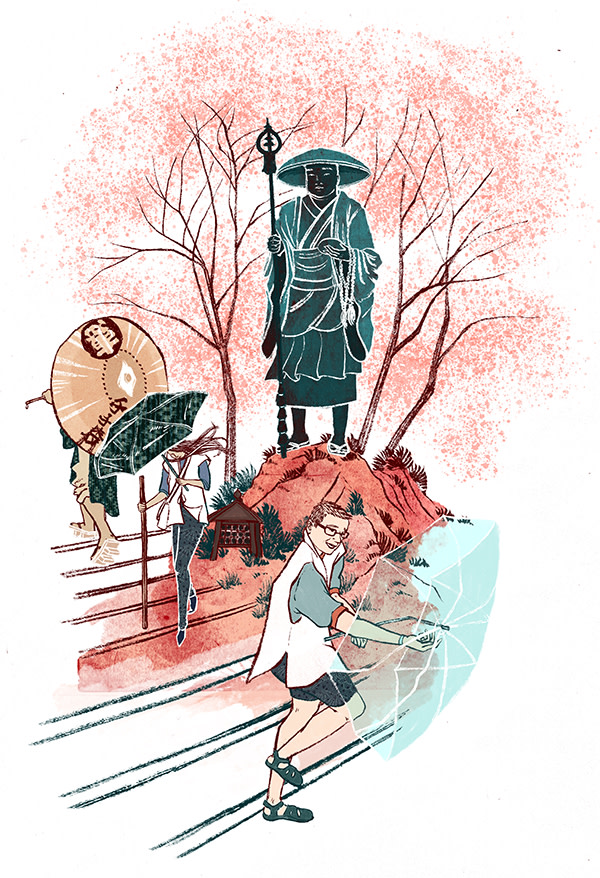
The orderliness and expectations of Japanese society can make it a suffocating place for some. The dominant organising system is sometimes the family or more often work. Nearly a century ago, Bohner wrote that the henro enabled pilgrims to “escape from the confines of their daily life, which has almost crushed them”. But Oyamada disagreed: “To me, the idea of escape implies turning your back. This is not about that,” he said. “This is about finding serenity. This is about refreshment.” He was clear, however, that institutional religion — feared as a new locus of control — had nothing to do with it.
Sociologists have talked about the “privatisation” of faith in the west, a shift from unified religions towards people concocting their own versions of spirituality in the same way they assemble their wardrobes. It has been lamented as an antisocial byproduct of too much individualism. But it is also happening in Japan, a place usually branded as too conformist, because it is a form of liberation.
Spirituality is a safety valve and the henro is an opportunity to use it. It does not come with a belief system that tells pilgrims what to do. They create their own selection of gods, ancestors, prayers, rituals and charms. “Then on Monday,” said Oyamada, “you go back to work and, even though you’ve got this unpleasant boss, you accept him as he is. Your heart becomes bigger.” The journey’s freewheeling faith explains its reviving power. Celestial liberty fosters terrestrial calm. The funeral robe is an ancient shroud, but it carries pilgrims to a new beginning.
Barney Jopson is the FT’s US policy correspondent and a former FT Tokyo correspondent
Illustrations: Cat O’Neill
Comments